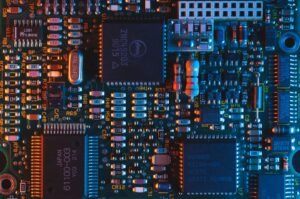Media AI dalam Pembelajaran
Artificial Intelligence (AI) telah mengubah cara kita belajar dan memperoleh informasi. Salah satu inovasi yang semakin populer adalah penggunaan AI dalam media pembelajaran. AI memungkinkan pembelajaran menjadi lebih interaktif, personal, dan efisien. Artikel ini akan menjelaskan apa itu media AI dalam pembelajaran, bagaimana hal itu dapat digunakan, dan manfaatnya bagi siswa dan pendidik.
Key Takeaways:
- Media AI dalam pembelajaran memungkinkan pembelajaran yang interaktif dan personal.
- Penggunaan AI dalam media pembelajaran mempercepat dan meningkatkan proses pembelajaran.
- Manfaat media AI dalam pembelajaran meliputi peningkatan motivasi dan keterlibatan siswa.
Apa itu Media AI dalam Pembelajaran?
Media AI dalam pembelajaran mengacu pada penggunaan kecerdasan buatan dan teknologi komputer untuk meningkatkan pengalaman belajar. Melalui penggunaan algoritma dan data-data yang ada, AI dapat memberikan pengalaman pembelajaran yang lebih personal dan interaktif bagi para siswa.
AI dapat memahami gaya belajar dan preferensi siswa, sehingga memberikan konten yang sesuai.
Bagaimana Media AI digunakan di Pembelajaran?
Penggunaan media AI dalam pembelajaran dapat beragam tergantung pada jenis aplikasi dan platform yang digunakan. Beberapa contoh penggunaan media AI dalam pembelajaran antara lain:
- Pembelajaran adaptif: AI dapat menganalisis dan menyesuaikan materi pembelajaran berdasarkan kemampuan dan kebutuhan individu siswa.
- Asisten virtual: AI dapat menjadi asisten virtual yang membantu siswa dalam mencari dan memahami informasi secara cepat dan akurat.
- Pemeriksaan pekerjaan: AI dapat digunakan untuk mengoreksi dan memberikan umpan balik otomatis terhadap pekerjaan siswa, yang mempercepat proses penilaian.
Manfaat Media AI dalam Pembelajaran
Penggunaan media AI dalam pembelajaran memiliki manfaat yang signifikan bagi siswa dan pendidik. Beberapa manfaat utama media AI dalam pembelajaran antara lain:
- Peningkatan motivasi: Media AI yang interaktif dan personal dapat meningkatkan motivasi siswa dalam belajar.
- Keterlibatan siswa: Penggunaan teknologi AI dalam pembelajaran dapat meningkatkan keterlibatan siswa dalam proses pembelajaran.
- Pembelajaran yang disesuaikan: Media AI dapat mengadaptasi materi pembelajaran sesuai dengan gaya dan kebutuhan siswa, yang dapat meningkatkan pemahaman dan prestasi akademik.
| Jenis Media AI | Deskripsi |
|---|---|
| Asisten virtual | Teknologi AI yang berfungsi sebagai asisten pribadi untuk mencari dan menyediakan informasi kepada pengguna. |
| Pembelajaran adaptif | Penerapan AI dalam pembelajaran yang dapat menyesuaikan materi pembelajaran dengan kebutuhan dan kemampuan siswa. |
Contoh Penerapan Media AI dalam Pembelajaran
Beberapa contoh penerapan media AI dalam pembelajaran yang telah dilakukan adalah:
- Sistem tutor AI yang dapat memberikan bantuan belajar personal kepada siswa.
- Aplikasi mobile yang menggunakan AI dalam pengajaran bahasa asing.
- Platform e-learning dengan media AI untuk mengadaptasi materi pembelajaran.
| Penerapan Media AI | Deskripsi | Manfaat |
|---|---|---|
| Sistem tutor AI | Teknologi AI yang berfungsi sebagai tutor personal yang membantu siswa dalam memahami materi pelajaran. | Meningkatkan pemahaman dan prestasi akademik siswa. |
| Aplikasi mobile AI | Aplikasi mobile yang menggunakan teknologi AI untuk memberikan pengajaran interaktif dalam bahasa asing. | Meningkatkan keterampilan berbahasa siswa dengan cara yang menyenangkan dan menarik. |
Media AI dalam Pembelajaran: Masa Depan Pembelajaran
Media AI telah membuka pintu bagi inovasi pembelajaran yang lebih personal dan efisien. Dengan terus berkembangnya teknologi AI, kita dapat mengharapkan penggunaan media AI dalam pembelajaran akan semakin meluas dan memberikan manfaat yang lebih besar bagi siswa dan pendidik di masa depan.
Dengan AI, masa depan pembelajaran akan menjadi lebih adaptif dan terpersonalisasi.

Common Misconceptions
1. AI being a replacement for teachers
One common misconception people have about Media AI dalam Pembelajaran is that it will replace teachers in the classroom. However, this is not the case as AI is designed to complement and enhance the teaching process rather than replace human interaction. It can provide support by automating administrative tasks, offering personalized learning experiences, and assisting with grading and feedback.
- AI can automate administrative tasks, freeing up time for teachers
- AI can provide personalized learning experiences tailored to each student
- AI can assist with grading and offering immediate feedback to students
2. AI having biases and reinforcing stereotypes
Another misconception is that Media AI dalam Pembelajaran is objective and free from biases. However, AI systems can inherit biases from their training data and algorithms, potentially reinforcing stereotypes. It is crucial to ensure that AI systems used in education are thoroughly tested, monitored, and continuously improved to mitigate these biases and promote fairness and inclusivity.
- AI systems can inherit biases from training data
- Continuous testing and monitoring of AI systems are essential
- Awareness and efforts to mitigate biases in AI systems must be made
3. AI replacing the need for human interactions
Some people mistakenly believe that Media AI dalam Pembelajaran can replace the need for human interactions in the learning process. While AI can provide valuable support and resources, it cannot fully replace the benefits of human interactions, such as emotional intelligence, empathy, and critical thinking. Collaborative activities, discussions, and teacher-student interactions remain crucial for a holistic and comprehensive learning experience.
- Human interactions foster emotional intelligence and empathy
- Collaborative activities and discussions promote critical thinking skills
- Teacher-student interactions provide guidance and mentorship
4. AI making decisions without human intervention
There is a misconception that AI in Media AI dalam Pembelajaran can make autonomous decisions without any human intervention. In reality, AI systems are designed to assist human decision-making rather than replace it. Human oversight and input are necessary to ensure that AI systems are aligned with educational goals, ethical considerations, and student needs.
- AI systems are designed to assist human decision-making
- Human oversight ensures alignment with educational goals and student needs
- Ethical considerations are crucial in the development and deployment of AI systems
5. AI being a one-size-fits-all solution
Lastly, many people have the misconception that Media AI dalam Pembelajaran is a one-size-fits-all solution that can cater to the needs of all students. While AI can provide personalized experiences, it is important to recognize that every student is unique with different learning styles, abilities, and backgrounds. AI should be implemented in a way that allows for flexibility and customization to meet the diverse needs of learners.
- AI can provide personalized experiences but may not suit everyone
- Flexibility and customization are essential for catering to diverse learners
- Recognizing individual learning styles, abilities, and backgrounds is important

Media AI Usage in Education
Artificial intelligence (AI) technology has permeated various fields, and education is no exception. This article explores the role of media AI in the realm of learning and teaching. Below are ten tables that provide interesting insights into this emerging trend.
AI Development in Online Learning Platforms
AI has greatly impacted online learning platforms by enhancing the learning experience and personalization. The following table displays the development and integration of AI features in different platforms.
| Platform | AI Features |
|---|---|
| Platform A | Adaptive assessments, personalized recommendations |
| Platform B | Intelligent chatbots, automated grading |
| Platform C | Virtual reality simulations, intelligent content selection |
Applications of AI in Teaching Materials
AI can revolutionize the creation and delivery of teaching materials. The table below showcases various applications of AI in the development of educational resources.
| Application | Description |
|---|---|
| Automated Transcription | Generating accurate transcripts from audio or video recordings |
| Language Translation | Instant translation of teaching materials into multiple languages |
| Content Generation | AI-generated quizzes, presentations, and study guides |
AI-Based Tutoring Systems
AI-powered tutoring systems offer personalized and adaptive learning experiences. The following table presents different AI-based tutoring systems and their key features.
| Tutoring System | Features |
|---|---|
| System X | Real-time feedback, adaptive learning paths |
| System Y | Natural language processing, interactive simulations |
| System Z | Emotion recognition, personalized recommendations |
The Role of AI in Grading and Assessment
AI streamlines grading and assessment processes, reducing the burden on educators. The table below highlights different tasks that can be automated using AI.
| Task | AI Automation |
|---|---|
| Multiple-choice grading | Automatic scoring based on predetermined answer keys |
| Essay evaluation | AI-powered analysis for grammar, vocabulary, and coherence |
| Plagiarism detection | AI algorithms comparing student work with online sources |
AI-Powered Virtual Classrooms
Virtual classrooms empowered by AI technologies provide innovative ways of remote teaching. The table below highlights AI features in virtual classrooms.
| AI Feature | Description |
|---|---|
| Automated attendance tracking | In-session attendance management and record-keeping |
| Intelligent content delivery | Real-time recommendations based on student behavior |
| Facial recognition | Identifying students and providing personalized feedback |
AI in Educational Research and Data Analysis
AI facilitates data analysis and research in the field of education. The table below showcases AI applications in educational research.
| Application | Function |
|---|---|
| Data mining | Extracting trends and insights from large educational datasets |
| Predictive modeling | Forecasting student performance and identifying at-risk students |
| Social network analysis | Exploring connections and interactions within educational communities |
Challenges and Ethical Considerations of AI in Education
While AI offers numerous benefits, there are also concerns and challenges associated with its implementation. The table below highlights these challenges.
| Challenge | Description |
|---|---|
| Data privacy | Managing and protecting sensitive student data |
| Algorithmic bias | Potential discrimination or unfairness in AI decision-making |
| Technology dependency | Overreliance on AI systems hindering critical thinking skills |
The Future of Media AI in Education
Media AI continues to evolve, promising transformative changes in education. Innovations like AI-powered intelligent tutoring systems and adaptive learning platforms are reshaping the learning landscape. Educators must navigate the opportunities and challenges to harness the full potential of AI and provide a richer educational experience for students.
Frequently Asked Questions
What is Media AI dalam Pembelajaran?
Media AI dalam Pembelajaran refers to the use of Artificial Intelligence (AI) in educational settings to enhance teaching and learning processes. It involves the integration of AI technologies, such as machine learning and natural language processing, into various educational media and tools.
How can Media AI improve the learning experience?
Media AI can improve the learning experience by providing personalized learning materials and recommendations based on individual students’ needs. It can also analyze students’ learning patterns and provide adaptive feedback to enhance their understanding and performance. Additionally, AI-powered media can support interactive and immersive learning experiences through virtual reality and augmented reality technologies.
What are some examples of Media AI in education?
Examples of Media AI in education include AI-powered tutoring systems, adaptive learning platforms, intelligent learning management systems, virtual reality simulations, voice recognition tools, and automated grading systems. These technologies can enhance student engagement, provide personalized feedback, and simplify administrative tasks for educators.
Can Media AI replace human teachers?
No, Media AI cannot replace human teachers entirely. While AI can support and augment teaching processes, the role of human teachers in education is crucial. Human teachers provide emotional support, guidance, critical thinking instruction, and social interactions that AI technologies cannot fully replicate. Media AI should be seen as a tool to empower and assist teachers rather than a substitute for them.
Is Media AI accessible for students with disabilities?
Accessibility is an important consideration in Media AI dalam Pembelajaran. Developers and educators need to ensure that AI-powered educational tools are designed with inclusive features, such as support for screen readers, text-to-speech capabilities, and customizable interfaces. By making Media AI accessible, students with disabilities can also benefit from the advantages of AI in learning.
What are the potential ethical concerns of Media AI dalam Pembelajaran?
There are several ethical concerns associated with Media AI dalam Pembelajaran. These include bias in AI algorithms, data privacy and security, transparency of AI processes, and the potential for replacing human interactions with AI systems. It is important for developers, educators, and policymakers to address these concerns and ensure responsible and ethical use of AI in education.
How can educators integrate Media AI into their teaching practices?
Educators can integrate Media AI into their teaching practices by exploring and utilizing AI-powered educational tools and platforms. They can incorporate adaptive learning systems, virtual reality simulations, and AI-powered assessment tools into their lessons to enhance student engagement and learning outcomes. It is important for educators to undergo training and professional development to effectively leverage Media AI in their teaching.
What are the benefits of Media AI for educators?
Media AI can provide several benefits for educators. It can automate administrative tasks, such as grading and data analysis, allowing teachers to focus more on instruction and student support. AI-powered tools can also provide insights into students’ learning progress and identify areas where additional support is needed. This can help educators personalize instruction and provide targeted interventions.
Can Media AI be used outside of traditional classroom settings?
Yes, Media AI can be used outside of traditional classroom settings. With the advancement of online and remote learning, AI-powered educational platforms and tools can be accessed from anywhere, allowing learners to engage in personalized and interactive learning experiences outside of physical classrooms. Media AI can also support lifelong learning by providing access to educational resources anytime and anywhere.
What is the future of Media AI dalam Pembelajaran?
The future of Media AI dalam Pembelajaran is promising. As AI technologies continue to advance, we can expect more sophisticated and intelligent educational tools and platforms. Media AI has the potential to revolutionize teaching and learning by providing personalized, adaptive, and immersive educational experiences. However, it is crucial to ensure that AI is developed and implemented responsibly, considering the ethical implications and addressing potential challenges.




